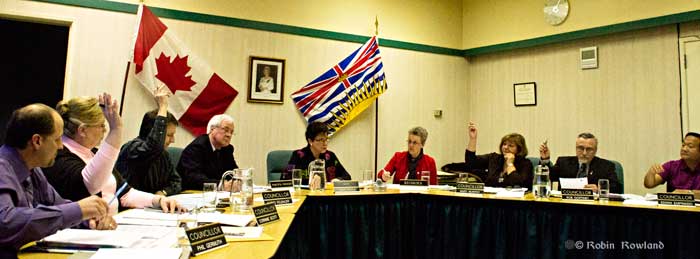
District of Kitimat council voted on Monday, April 2, to ask the Northern Gateway Joint Review Panel to ensure that the town’s water supply is protected if the controversial pipeline is built. A second motion called on Enbridge to give the district a detailed and public presentation on its provisions to protect the water supply in the case of a pipeline breach along the Kitimat River.
That second motion was passed after a motion from Councillor Phil Germuth holding Enbridge responsible for any disruption to the water supply was defeated by a vote of 4-3. However, council’s new motion did not preclude Germuth asking Enbridge his original questions about liability.
Germuth had presented council with the two original motions, after a presentation in March
by Douglas Channel Watch about the dangers avalanches could present to the Enbridge twin pipelines along the Kitimat River watershed.
The first motion called on the District of Kitimat to present a written position to the Joint Review Panel based on the district’s status as a government participant emphasizing the potential dangers to the water supply and noting that the mayor and council are “legally responsible to make every effort to ensure the city of Kitimat’s water supply is uninterrupted and of the highest quality.”

After introducing the motion, Germuth said he believed the motion went along with council’s position to remain neutral because nothing in the motion took a position for or against the project.
Councillor Mario Feldhoff said he supported the motion without supporting all the details of Germuth’s full statement, a indication of the more intense debate to come over the second motion.
Mary Murphy also supported the motion, pointing to the potential problems of “transporting hydrocarbons” by both tanker and pipeline.
Mayor Joanne Monaghan said she had a problem with the motion because had earlier passed a motion saying it would wait to take a position until after the Joint Review Panel had reported.
Councillor Corinne Scott said she would speak for the motion, agreeing that this was a request for information and not saying council was for or against the project, adding “we are all concerned about the potential of what could happen to our water supply.”
Read Councillor Phil Germuth’s motions (pdf)
Feldhoff agreed that a letter to the JRP was not taking a position, adding, that on receipt of a letter the Joint Review Panel should take a very serious look at the issue of the water supply of Kitimat. Monaghan agreed but said if the council was to write the letter that it be accurate.
Feldhoff then proposed a friendly amendment calling on District staff to write a draft letter to the Joint Review Panel that council could then examine and agree to.
With the amendment, the motion passed unanimously.
Germuth’s second motion was more contentious, calling on Enbridge to provide detailed plans for ensuring the quality of water for the District of Kitimat and accepting “full liability” for the restoration of the Kitimat’s “entire water system” in case of a pipeline breach. Although some councilors had reservations about Germuth’s list of items, they agreed that Enbridge be called to meet council “face to face,” as Monaghan put it, by responding in person rather than by letter.
Enbridge had already responded to the motion from the previous meeting, calling on it to respond to the concerns raised by Douglas Channel Watch about the possibility of avalanche danger in the Nimbus Mountain area.
In an e-mail to council, Michele Perrett of Enbridge maintained that most of the issue had been addressed by Enbridge in either its original filing with the Joint Review Panel or by subsequent responses to information requests to the JRP, adding
Specifically we have filed geotechnical studies and responded to information requests that include information on avalanches, rock fall, glaciomarine clay slides, debris flows and avulsion in the Kitimat area and have reviewed information filed on this subject by intervenors.
The e-mail said that Drum Cavers, a geotechnical specialist would be making a presentation to council on Monday, April 16.
Enbridge e-mail to District of Kitimat Council (pdf)
Monaghan noted that Douglas Channel Watch and other groups are limited by council policy to 10 minutes and that Murray Minchin had told council that to be fair, Enbridge’s response should also be limited to 10 minutes. Council agreed that the 10 minute limit is needed to make sure that council meetings finish on time and there was some discussion of allowing Enbridge to make a more lengthy presentation outside of a regular council meeting. That would allow Enbridge to not only respond to the earlier concerns about the Nimbus Mountain avalanche danger but also to the concerns about the town’s water supply.
Some members of council, led by Feldhoff, also expressed reservations about the seven points raised by Germuth; others wanted to possibly add their own concerns to any questions for Enbridge. Feldhoff was not prepared to vote for the original motion without more information.
Feldhoff then asked that the district administration prepare a report on the water supply, saying “I think the concerns may be somewhat overstated at the moment.” Councillor Rob Goffinet also called for a report from district staff on the “ramifications for our water supply,” adding that council should not “engage with Enbridge” until that report was ready.
Germuth’s motion, with all of the original questions, along with the invitation for Enbridge to make a public presentation, was then defeated by a vote of 4-3.
Councillor Scott then moved as part of the presentation that Enbridge was earlier invited to present that water issues be added to the list and that council draft a list of questions for the company, that could include Germuth’s original questions.
Germuth asked if the council could put a time limit on Enbridge’s response because the federal budget calls for limiting to the Joint Review Panel. Feldhoff responded that the new motion concerned council’s concerns just with Enbridge and that council should be respectful of Enbridge and hopefully the company could integrate those questions as well.
Goffinet said he wanted Enbridge to know all of the district’s concerns and so, in effect, this motion would get what Councillor Germuth wanted but by a different route, adding that if Cavers, Enbridge’s geotechnical expert, was unable to answer the question, Enbridge would be asked to return and answer the questions at a later date at a public meeting.
That motion passed unanimously.
Update:
Mary Murphy clarified her remarks in an e-mail by saying
I stated I had concerns with all hydro carbons transported along the river coastline…like CN Rail and transporting hydro carbons and the likelihood of a derailment etc, andhow that would also effect our waters. CN Rail is and has been transporting hydro carbons, etc for some time, and have had severe derailments.













